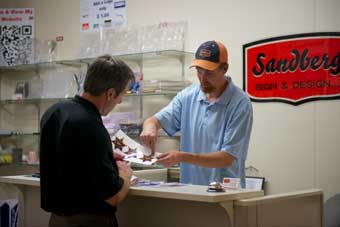Graphic print shops face numerous challenges—from large-scale competition to tight budgets to reliance on old equipment—
and expanding into a full-time graphics shop might seem insurmountable.
The reality is, with strategic planning that incorporates the right technology and services, becoming a full-time graphics shop is not as challenging as it seems. And great rewards can spring from the incremental revenue of the signage business syncing with commercial print workflow and economies.
As with all business transitions, a company needs to develop a plan or outline for expanding into a full-time graphics shop that details the steps to success.
When looking at those steps, a shop should focus on the value-added solutions—not commodities—that will help them expand their business and applications. Hardware and software are obvious considerations that we will delve deeper into.
However professional services is a key component that is often overlooked—and having a partner is crucial here.
The Hardware
Finding hardware that provides high-quality color printing, the most valuable features, and a substantial return on investment is important.
Here are a few things to look for when deciding on solutions:
Printers. Having a range of devices—from cutsheet to wide format to possibly even continuous-feed—is key to producing the variety of applications your customers are demanding.
For signage, in particular, advances in some cutsheet devices enable banner printing, and wide format devices open up even larger formats. Roll-fed and flatbed wide format devices are both types that should be considered for their versatility.
Media. The right media can make or break a job. From 3D lenticular media to static clings to fabric and more, substrates can turn a small business card or large sign into a work of impactful art.
Therefore it is important to find equipment that can print on a wide variety of substrates without reducing quality and that has a media library to match.
Inks. Devices that can print clear, white, or metallic inks enable a wider range of eye-catching applications such as embossing, spot color treatments, printing on transparent and dark stock, and more. Beyond looking good, these specialty applications enable new revenue opportunities when transitioning to full-time work.
Finishing. How you finish is as important as how you begin. For example, being able to laminate hundreds of fliers can change them from the typical handbill to something of substance that people will take a closer look at.
A solution that offers strong finishing options can be the difference between a good final product and a great one.
Projection Technology for Digital Signage. In 2013, InfoTrends reported that digital signage was a rapidly-growing market. Rather than replacing traditional print signage, digital signage is actually complementing it.
For example, companies at tradeshows are using printed banners side-by-side with projector-enabled “digital walls.” Being able to produce multichannel campaigns that support projects like these is key to growth.
The Software
Even with the best printing equipment, if you do not have the software tools to manage your operations, success in transitioning to a full-time signage shop will be elusive.
So what is needed for success?
Multichannel marketing tools. In today’s digital world, pulling together just a series of signs, a direct marketing print piece, or a flyer is not enough to attract a customer’s attention. Marketers look to their print shops to act as marketing service providers—offering digital solutions to accompany print ones. Graphics shops that don’t take into account ways to help customers create multichannel campaigns that offer a digital element (QR code, pURLs, e-mails, etc) risk being overwhelmed by competition.
It is important to tap into software like web-to-print and variable data printing offerings that can help you manage your client’s marketing assets, insert them into pre-created or custom templates, modify parts of the campaign in real time, customize output with customer data, and even track responsiveness.
In addition, having software that helps customers analyze their data and pinpoint the right message for the right audience can help a company truly stand out from other graphics shops.
Workflow solutions. Man hours cost money and can lead to mistakes—plain and simple. Having a set of solutions in place that can automate what were normally manual tasks will save time and money.
Print management software allows your business to schedule and track print jobs, automate manual tasks, create processes, and handle maintenance issues with fewer human touch points and bottlenecks, which can help your business make better print decisions and avoid wasteful and costly mistakes.
Another type of workflow solution to consider is easy-to-implement digital storefronts that allow you to streamline order fulfillment from order placement to delivery and offer your new and returning customers a pleasant online ordering experience.

Sales tools. Being able to produce high-quality signs, brochures, business cards, billboards, and more is the first and biggest step for a sign shop. But being able to essentially “market to marketers” (who are often your customers) and show off what you are capable of producing for potential new customers is also important.
Consider curating a “kit” of applications showcasing a wide variety of inks, formats, substrates, and the quality of your services.
Color Management. Color is by far one of the key elements in all graphics shops that provide marketing services because it ensures consistency across all pieces in a campaign.
For example, if your client’s project includes a banner sign, a digital screen, and a point-of-sale display side-by-side, the color for all of these should be the same for consistency and brand recognition (e.g., Coca-Cola® red cannot be two different shades of red).
Color management spans software, hardware, and services, and it requires expertise and training in calibrating and maintaining devices.
Having the right partner as you expand the color management abilities that your customers will need is even more essential.
Professional Services
Services go beyond your vendor coming to repair your machine when it is down.
As you grow your business, taking a step back to identify your strengths, weaknesses, opportunities, and threats is an absolute necessity. While you can do this analysis yourself, working with a partner that makes your business needs and interests their own is a wise investment.
During your transition, you will want an evaluation of your unique business needs and scenarios as well as interviews with your management team and operators to identify the gaps between your present performance and offerings and your goals and future scenarios.
One aspect of a partnership is software and hardware-oriented services like training employees, offering certifications, installing and calibrating solutions that best fit your business needs, assessing your workflow, and web-to-print workflows.
Other advisory aspects that you can achieve through partnerships are training your sales force and operators, assisting with social media and marketing, and receiving creative and design expertise.
The path to success for a sign shop looking to become a full-time graphics shop will take some time. But with a strategic, value-driven approach, the leap will not seem so daunting, and the results in expanding your business will be worthwhile.
By John Fulena is vice president, Production Printing Business Group, at Ricoh Americas Corporation.
All photos: Ricoh USA & SAi.











